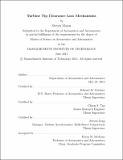| dc.contributor.advisor | Edward M. Greitzer, Choon S. Tan, and Steven Gegg. | en_US |
| dc.contributor.author | Mazur, Steven (Steven Andrew) | en_US |
| dc.contributor.other | Massachusetts Institute of Technology. Department of Aeronautics and Astronautics. | en_US |
| dc.date.accessioned | 2013-11-18T20:41:18Z | |
| dc.date.available | 2013-11-18T20:41:18Z | |
| dc.date.copyright | 2013 | en_US |
| dc.date.issued | 2013 | en_US |
| dc.identifier.uri | http://hdl.handle.net/1721.1/82486 | |
| dc.description | Thesis (S.M.)--Massachusetts Institute of Technology, Dept. of Aeronautics and Astronautics, 2013. | en_US |
| dc.description | This electronic version was submitted and approved by the author's academic department as part of an electronic thesis pilot project. The certified thesis is available in the Institute Archives and Special Collections. | en_US |
| dc.description | Cataloged from department-submitted PDF version of thesis | en_US |
| dc.description | Includes bibliographical references (p. 97-98). | en_US |
| dc.description.abstract | Three-dimensional numerical simulations (RANS and URANS) were used to assess the impact of two specific design features, and of aspects of the actual turbine environment, on turbine blade tip loss. The calculations were carried out for a subsonic high pressure turbine stage. The loss mechanism examined is that due to tip clearance vortex mixing. The effects examined were three-dimensional blade stacking, downstream transition duct geometry, and unsteadiness due to an upstream nozzle guide vane. Tip leakage loss changes due to three-dimensional blade stacking (bowing or reverse bowing) are verified to be associated with changes in the magnitude of blade tip loading, which create differences in the leakage flow exit velocities. The effect of a downstream diffusing transition duct on tip leakage losses is small; there was a 3.6% increase in tip leakage loss for a 65% increase in duct exit-to-inlet area ratio compared to a constant area duct. For unsteadiness arising from an upstream nozzle guide vane, it is shown that substantial temporal fluctuations in vortex core velocity and loss generation exist. However, the time average tip leakage loss differed less than 5% from the tip leakage loss calculated on a steady flow basis. Based on the computations, the mechanism for tip leakage vortex loss in the three different situations examined appears to be similar to that which is seen for an isolated turbine blade. | en_US |
| dc.description.statementofresponsibility | by Steven Mazur. | en_US |
| dc.format.extent | 98 p. | en_US |
| dc.language.iso | eng | en_US |
| dc.publisher | Massachusetts Institute of Technology | en_US |
| dc.rights | M.I.T. theses are protected by
copyright. They may be viewed from this source for any purpose, but
reproduction or distribution in any format is prohibited without written
permission. See provided URL for inquiries about permission. | en_US |
| dc.rights.uri | http://dspace.mit.edu/handle/1721.1/7582 | en_US |
| dc.subject | Aeronautics and Astronautics. | en_US |
| dc.title | Turbine tip clearance loss mechanisms | en_US |
| dc.type | Thesis | en_US |
| dc.description.degree | S.M. | en_US |
| dc.contributor.department | Massachusetts Institute of Technology. Department of Aeronautics and Astronautics | |
| dc.identifier.oclc | 862232868 | en_US |
